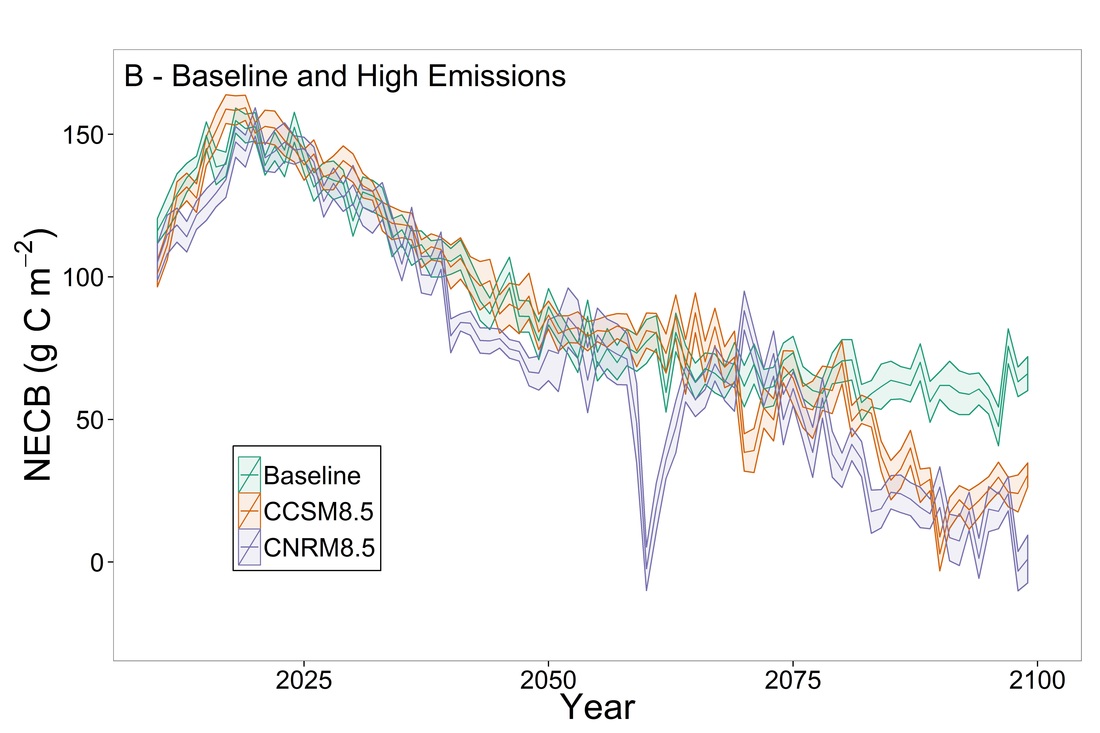|
Temperature and precipitation influence where tree species are capable of growing and how quickly they grow in a particular location. Climate essentially acts as a filter on what species can occur in a given location. Another filter that influences both species occurrence and growth is what other species are growing in a particular location. This is because individual trees are competing for resources (water, light, space) and resource requirements and competitive ability varies between species. As a result, even if climatic conditions are sufficient for a species, the species may be excluded from a site because it can’t compete with other species that are already present on the site. In a recent study led by Danelle Laflower, we set out to determine how changing climate would influence the distribution of species and how quickly they would grow and store carbon. We also wanted to determine if management activities could alter the effects of changing climate on the forest’s ability to store carbon. We conducted the study at Joint Base Lewis-McCord (JBLM) in Washington with support from the Department of Defense’s SERDP program. JBLM is an important piece of real estate from an ecological perspective because it is situated in a highly fragmented environment. It is predominantly Douglas-fir forest, but also contains patches of old-growth western hemlock and western redcedar. The other attribute that makes this site ecologically important is that it contains prairies and woodlands that are home to several threatened or endangered species. Over the past 90 years or so, the prairies and woodlands were invaded by Douglas-fir trees, converting much of their original area to forest cover. In the absence of disturbance, the natural progression in these forests is from Douglas-fir to western hemlock and western redcedar. This is because Douglas-fir requires more light for seedlings to establish and has trouble regenerating in its own shade, whereas western hemlock and western redcedar are capable of regenerating in their own shade. We used the LANDIS-II model and climate model projections from moderate and high emission scenarios to simulate forest dynamics. While both emission scenarios resulted in warmer temperatures and generally lower precipitation, the higher emission scenario causes more warming and lower summer precipitation. The increase in temperature is greatest during the second half of the 21st century. We also included management scenarios that included a no-action control, prescribed burning, thinning, and thinning and prescribed burning. To determine the effect of changing climate on the number of species at each location across the installation, we looked at the number of locations (frequency) that had a particular number of tree species. We found that there was little difference in species richness (# of species) between simulations run with historic or baseline climate (red line) and simulations run with climate from the moderate emission scenario (blue and green lines). However, when we ran simulations with climate from the high emission scenario we found a decrease in the number of areas with a larger number of tree species (purple and orange lines). This was in part the result of lower growing season precipitation. Under the historic and moderate emission climate scenarios, moisture loving species like western hemlock and western redcedar are able to establish and grow under Douglas-fir. Under the high emission scenario, dry, warm summers prevent these species from establishing. To measure the effects of changing climate on forest growth and carbon storage, we used net ecosystem carbon balance (NECB). NECB is measure of how much carbon is moving between the atmosphere and the forest. When NECB is above zero, the forest is removing carbon from the atmosphere and when it is below zero, the forest is losing carbon to the atmosphere. The larger the NECB value, the more carbon the forest is removing from the atmosphere. Similar to the species richness results, climate from the moderate emission scenario (left panel, orange and purple) had little effect on NECB compared to the historic climate scenario (left panel green). However, under the high emission scenario (right panel orange and purple), the forest showed a steep decline in how much carbon it was removing from the atmosphere each year beginning in 2075. Since part of the decrease in the forest’s ability to remove carbon from the atmosphere is driven by trees competing for water, we evaluated the effects of different management actions on NECB. Typically when a dense forest is thinned to reduce competition, the remaining trees grow faster and remove more carbon from the atmosphere. We thought that thinning or burning might reduce competition and slow the decline in how quickly the forest was removing carbon from the atmosphere. We found that thinning (left panel green) and thinning combined with prescribed fire (left panel purple) both increased NECB relative to the control (left panel red) after about 40 years under baseline or historic climate scenario. This caused the rate of carbon being removed from the atmosphere to stabilize beginning around 2050. Under the high emission climate scenario (right panel), these management actions also increased NECB compared to the control, but they were unable to stop the overall decline that was caused by higher temperatures and lower summer precipitation. Our results demonstrate that the changes in climate that we expect with a business-as-usual high emission scenario could cause a decrease in growth and a reduction in tree species richness. In areas that are especially water-stressed, this could prevent the natural progression of changes in dominant tree species.
0 Comments
|
Details
Archives
October 2023
Categories
All
|









 RSS Feed
RSS Feed